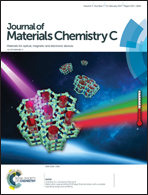Fluorescent Si QD decoration onto a flexible polymeric electrospun nanofibrous mat for the colorimetric sensing of TNT†
Abstract
UV range light was used for the facile, effective and large-scale synthesis of visible light emitting, surface-protected silicon quantum dots (Si QDs) starting from an amine-functionalized alkoxy silane precursor. Within mild and easy hydrolysis/condensation environments, the use of an amine-functionalized precursor together with a reducing agent resulted in a bright visible green light that could be used for fluorescent analytical detection systems. Visible light emitting Si QDs were investigated and it was found that their emission character depends on the illumination time, hydrolysis/condensation conditions and pretreatments for the silane coupling agents. A Nylon 6,6 electrospun nanofibrous mat was selected as a substrate for decoration by the Si QDs in order to fabricate a flexible and free-standing polymeric nanofibrous mat posessing a visible light emitting character so that it could act as a visible colorimetric sensor. The visible light emitting Si QDs were decorated onto the Nylon 6,6 nanofibrous mats via covering the surfaces as a ‘nanodress’ by a simple impregnation/dip-coating and heat-curing methods. The analytical results revealed that the Si QDs decorated flexible polymeric nanofibrous mats could be utilized for colorimetric trinitrotoluene (TNT) detection in low concentrations.



 Please wait while we load your content...
Please wait while we load your content...